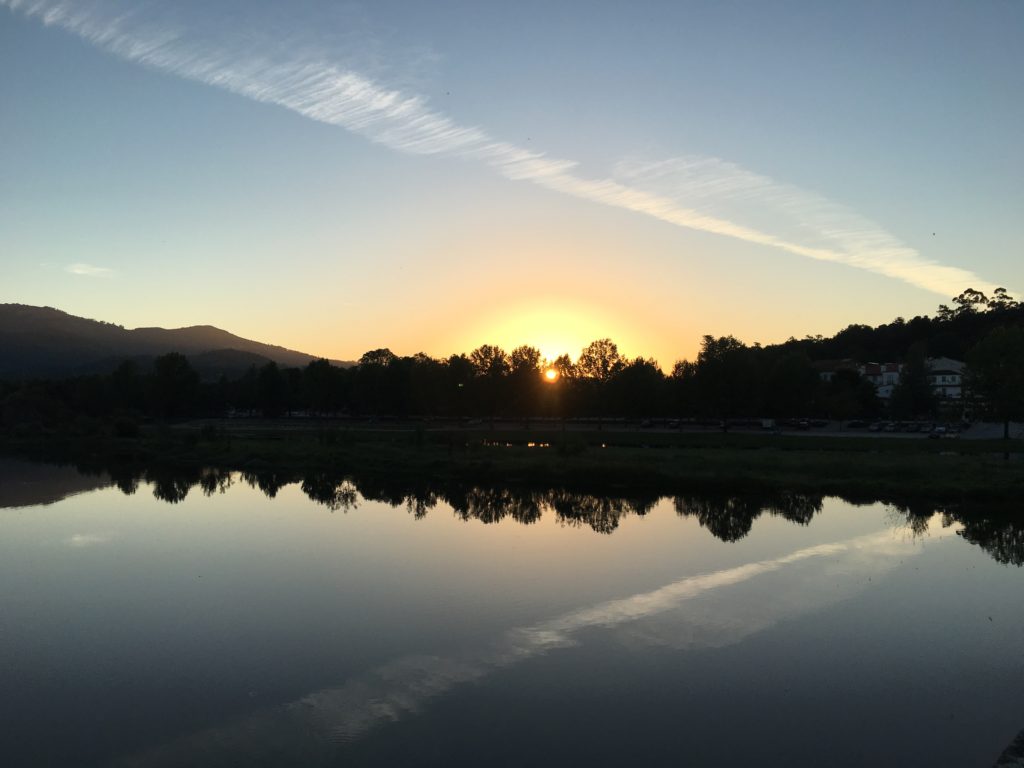by Abby Deatherage
https://worthsayingwell.wordpress.com/
@justabbyd
At the completion of my year living in England, I spent 7 days walking from Barcelos, Portugal to Santiago de Compostele, Spain before I flew back to London and from London, home to Washington, D.C.
The Portuguese Camino is a path well-trodden: for centuries, pilgrims ranging from kings and queens to humble, everyday churchgoers walked the ancient route on a pilgrimage to Santiago de Compostele, where St. James’ remains are said to be buried. It’s famous as one of many different routes to Santiago, and modern-day pilgrims are just as varied in vocation, nationality, and religious or spiritual beliefs. When I first decided to take on the walk, I saw it as a physical challenge and a unique experience. But as I realized that it came at the end of an important year of my life before I moved back to the States, I began to see it as an opportune time for reflection on the year past, as well as prayer for the year ahead. Not long before I began, I received the opportunity to read a book by one of my mentors at the University of Virginia, Karen Marsh: Vintage Saints and Sinners: 25 Christians who Transformed my Faith.
I sat at the feet of Karen Marsh and listened all through my university years, and longed to be just like her. Each Friday, I and other university students walked down a shady street to her house, helped ourselves to fried chicken or lasagne, green salads, yummy cookies spread on her grand dining room table, and found a seat to settle in (sometimes literally at her feet) in the Marsh’s living room. Once we were all settled, holding our readings for that day, Karen lit a candle and read to us, writings and thoughts from Christians of different eras, Christians whose walk, she believed, we could learn from; some whose lives were already known and others who were not as well known. With her calming, wise voice, she read to us and with piercing clarity, asked questions about our reactions to the sometimes challenging words of these “vintage Christians,” as she called them. Now, her book would take those Friday afternoons and turn them into written word and reflection, and I decided instantly to read chapters and reflect as I walked the Camino.
So we began, walking in the footsteps of ancient pilgrims, sometimes literally, sometimes figuratively as we walked over hills and through valleys, along the paved roads of hillside villages and cities or through quiet forest paths. We awoke in the early morning, setting out into the quiet street as the soft, chill rays of the sun were just awakening the sky; we walked in the cool morning air and silence that wrapped the world in its precious stillness, save for the occasional crow of a rooster. Through the morning hours, our feet carried us along the path, sometimes with nothing to mark it but a simple yellow arrow, pointing us on, until we arrived at our daily destination, about 20 kilometers and 6 hours from where we had begun that morning. It was green and lush; we passed rows and rows of hanging purpling grapes, not quite ripe, and trees laden with heavy growing fruit. Hard blue sky, warm summer sun, pressing onward hour after hour.
Those hours were long with nothing to do but walk and talk, and so I began reading Vintage Saints and Sinners along the way: around a chapter a day, as early as possible, so that Icould spend the day meditating over each sinner-saint’s words. Following the directive of the first chapter’s title, “Take a Long Walk,” I walked the path that saints and sinners had for centuries before me.
I learned from their footsteps and their thoughts, their mistakes and their trials. From Kierkegaard, I learned to pray as I walked. From Henri Nouwen, I was reminded of my position as the Beloved of God; from Therese of Lisieux, contentment in serving God despite difficulty; from Flannery O’Connor, the mystery of God (that was a contemplative day); from Augustine, the wrestling with sin and the desire to obey God. I read each chapter through once or twice, and they gave me new ways of looking at the world and at God as I walked. Karen is right: the sinner-saintscan teach us so much about the character of God, and the fallibility of humans.
As we followed each yellow arrow onward, passing highways, in quiet towns and between fields of corn, I thought and prayed about these lessons from those who had gonebefore me. I reflected on my own life, processing the past year I’ve spent in England and the experiences I’ve had. I thought about the future, how I want to be shaped and what I might want to do; how I desire to act and listen and learn.
Reading and walking, thinking and doing: the conversation between these two ideas is one I am constantly striving to keep open. I thought about my life while on the Camino; now I can act on those thoughts. But I’m learning, always learning, from older Christians, whether they are unknown to me on the pilgrimage, immortalized in the pages of Karen’s book, or people like Karen herself, wise and honest about their own journeys. It’s a reminder to learn from those older and wiser than me–their mistakes and their successes. And it’s a beautiful thing, to take such intentional time to learn and reflect, before I take those words and turn them into actions in the world. I’m savoring the experience, savoring the soul-searching and thankful for the guides along the way.

